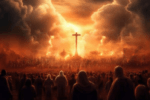Because Turkey is the backdrop for so much of the New Testament, traveling there opens a world of biblical understanding.
Few Christians realize that more than 66 percent of New Testament sites, and many Old Testament ones as well, are in Turkey. The maps in our Bibles identify this country as Asia Minor, so the confusion is understandable. But once Christians realize that Asia Minor is modern Turkey, a new world of biblical travel opens up.
Exploration of our rich Christian heritage in Turkey will focus on the cross, the cave and the crown. The cross brings us into contact with apostolic Christianity, the cave takes us into the world of the Cappadocian Fathers with their rich theology of the Holy Spirit, and the crown represents the rich Christian civilization of Byzantium.
Apostolic Preaching
It was in Antioch that the followers of Jesus were first called Christians. Modern Antioch, close to Turkey’s fourth-largest city, Adana, is one of the richest Christian archaeological sites. St. Peter’s Cave Church is probably the oldest church in the world and according to a reliable tradition was founded by the apostle himself.
Towering over the city is the Fortress. From here there are magnificent views of the entire Amik Plain and Orontes Valley. Nearby is Mount Simeon, where the fifth century Syrian hermit, Simon the Stylite, spent 40 years in prayer and preaching, attracting large crowds, before he eventually perched himself on top of the stone pillar on which he remained until his death. Strange though Simon’s actions seem, there is little doubt that his unusual lifestyle brought about a revival of Christian faith and spiritual life throughout the entire region.
From Antioch it is a short journey to the ancient port city of Seleucia Pieria, at the mouth of the Orontes River, where the ingenuity of Roman engineering is evident. This site will dispel the delusion that the gospel was originally proclaimed to a primitive people who had little in common with the modern world. The gospel was first preached to a people who lived in the most highly sophisticated and technologically advanced society humans had known.
Visiting Seleucia Pieria convinces the traveler that Jesus’ followers were not “simple peasants” who “knew no better” than to accept the message of the cross. The Romans were great engineers and as skeptical as anyone in history.
Yet when the gospel came to Antioch, it took root and continued to flourish for hundreds of years. Visiting such a rich archaeological site gives Christians a perspective on our world that helps them see beyond today’s problems and grasp the majesty of God’s history.
From Antioch a visit to Tarsus, the birthplace of the apostle Paul, is a good idea. The main attraction here is Paul’s well, an important pilgrimage site for Turkish and other Eastern Orthodox Christians.
All the cities of the seven churches of Asia mentioned in the book of Revelation–Ephesus, Pergamum, Thyatira, Sardis, Philadelphia, Laodicea and Smyrna–are relatively close to modern Izmir, ancient Smyrna. Philadelphia is now Alashehir, Thyatira is now Akhisar, modern Bergama shares the site of ancient Pergamum, and today’s Goncali is below the desolate site of Laodicea.
A visit to the site of ancient Ephesus, located near the modern city of Kusadasi, is a must. Many believe Ephesus is the best-restored biblical site in the world. It contains a number of magnificent ancient monuments such as the Marble Way, the Library of Celsus, the Theatre, and Terraced Houses. According to one legend that dates back to at least the second century, the disciple John brought Mary, the mother of Jesus, here after the crucifixion. On a nearby pine-covered mountain is the House of the Virgin Mary, where many believe Mary lived until her death.
The Caves: Birthplace of Charismatic Theology
Early Christian theologians living in Turkey shaped the future of the Christian church by developing a rich theology of the Trinity that paid particular attention to the role of the Holy Spirit. Today most of these theologians are unknown to the average Western Christian, but their theologies are foundational for us.
The center of this dynamic Christian movement was located in the semi-desert environment of Cappadocia. Many Christians retreated here from the dangers of a hostile society to the safety of caves, where they could meditate on Scripture and spend their days in prayer. Modern Cappadocia contains rich archaeological sites and some living monasteries, which originated in the early church.
After the Council of Nicea, at which the issue of Christ’s deity was finally settled, the church began to grapple with the question of the nature and role of the Holy Spirit. Even some orthodox theologians such as Eustathius (A.D. 300-377), Bishop of Sabaste, were confused on this issue. As the Jesuit scholar Anthony Meredith points out, Eustathius believed that “the Spirit was neither creature nor creator, but something in between.”
These views were attacked by Basil the Great (A.D. 329-379), a pupil of Eustathius, who saw how unbiblical and destructive of spirituality such teaching was. Basil argued against this view in his On the Holy Spirit (A.D. 375). In this book Basil carefully analyzes the meanings of specific words and the working of grammar to prove beyond any doubt that Scripture teaches a dynamic doctrine of the Holy Spirit as the Third Person of the Trinity.
Although his great work was not easy reading, its effects were devastating because he showed that his opponents misunderstood Scripture and the nature of God. Today not many people read Basil, but all Christians, particularly charismatics, owe him a great debt.
The other great charismatic theologians of Cappadocia were Basil’s brother, Gregory of Nyssa (A.D. 335-394), and his great friend Gregory of Nazianzus (A.D. 330-389). Both developed what today we recognize as the orthodox view of the Holy Spirit. All three made significant contributions to the development of Christian worship and personal piety through their extensive writings.
Although the Arabs conquered Cappadocia in A.D. 726 they were unable to stamp out this vibrant expression of Christianity, which was still flourishing when a French traveler visited the region in the 18th century. Only during the latter years of the Ottoman Empire in the 19th century did real decline set in. Yet even today there are a few isolated Christian communities.
Throughout the region are numerous church buildings rich in Christian art and history. Not to be missed in this region are the 16 cave churches that now form part of the Göreme Valley Open-Air Museum. The churches were carved out of living rock by early Christians and decorated with rich frescoes between the sixth and 10th centuries. Numerous undecorated cave churches also exist in the area.
Visiting the nearby Byzantine monastic complex of Zelve and the underground city of Kaymakli is an experience one never forgets. Here the visitor feels a strange tranquility and a sense of the richness of Christian history. Although large Christian communities no longer exist here, there is no doubt that the whole area is a remarkable witness to the gospel and the power of a charismatic theology that left its imprint on both people and nature for almost 2,000 years.
The Conversion of an Empire
Most modern Christians can appreciate the origins of the apostolic church and the theology of the Cappadocian Fathers, but the legacy of Byzantium, as found in the city of Istanbul (formerly known as Constantinople), is another matter. Here we come face to face with imperial Christianity, and many today feel distinctly uncomfortable. Yet modern secular prejudice ought not to blind us to the great achievements of the Byzantine church.
Founded by Greek settlers 2,500 years ago as Byzantium, the city was greatly extended and renamed New Rome in A.D. 330 by Roman Emperor Constantine. He made the city the capital of the Roman Empire because of its excellent
defensive position, and over time it acquired the name Constantinople.
It is a city rich in both spiritual and secular history. Until its conquest by Muslim armies in 1453, a great Christian civilization flourished here that did all in its power to spread the gospel throughout the world. Byzantine missionaries converted the Ukrainians, Russians and many other peoples, as well as sent missionaries to India and China in what was one of the most sustained missionary projects in history. Yet few of us in the West know anything about this remarkable work of God.
A good way to begin a visit to Istanbul is to take a short trip to the 14th century Galata Tower. From here you get views of the city that give a real sense of its history and magnificence. A trip to the Spice Market introduces you to the world of the Orient. The old city–with the Roman Hippodrome, churches such as St. Saviour in Chora and the world famous Museum of Antiquities–is truly exciting.
The jewel in the crown, however, is the great church of Hagia Sophia, built between A.D. 532 and A.D. 537 by the Byzantine Emperor Justinian (A.D. 482-565). For centuries this architectural wonder was used as an apologetic argument by Christian preachers to taunt Muslims with the charge that Islam was a parasitic religion built from scraps of Christian teachings. The “proof” of these charges, Orthodox Christians declared, was the inability of Muslim architects to replicate the dome of Hagia Sophia.
Ironically, after the conquest of Constantinople in 1453, Hagia Sophia was turned into a mosque. After World War I and the fall of the Ottoman Empire, the church became a national museum. The Turkish government restored it to its original state for celebrations marking the year 2000 by removing more than 3 feet of plaster from the mosaics on the roof and walls. This is truly one of the great churches and artistic treasures of the world.
Opposite Hagia Sophia is the stunning Blue Mosque. Here too is one of the great art works of the world. It reminds Western Christians that for centuries Christians, in what was the Turkish Empire, lived side by side with Muslims and carried on a vigorous dialogue of a type that would be almost impossible today.
Fortunately, Turkey is one of the more enlightened countries in the Muslim world. It is a secular state that allows considerable freedom of religion and debate.
Since September 11, 2001, Americans have been understandably worried about travel in the Muslim world. Therefore, it is important to add that travel in Turkey is probably as safe if not safer than travel in many parts of the United States. Crime in the cities is relatively low, and the people are incredibly friendly.
Not everyone there can speak English. But, as a people, the Turks are hospitable and kind. Some say Turkey is the best-kept tourist secret in the world. Certainly visiting Turkey compares well with a visit to Israel and can be a spiritual experience that lasts a lifetime.
Irving Hexham is a professor in the department of religious studies at the University of Calgary. He is also the editor of Zondervan’s Christian Travelers Guides series, with Charles Nienkirchen, professor of Christian history and spirituality at the Nazarene University College in Calgary. Nienkirchen has taken tour groups to Turkey for the last 10 years.
Retracing an Ancient Journey
Our vacation to Turkey and the Greek Isles was rich with spiritual meaning.
In September 2003 we had the experience of a lifetime when we joined a tour to biblical lands directed by First Century Voyages, an organization founded by David Spence to promote travel based on Christian history themes. This experience became a lasting demonstration to us of how God dramatically molded events in the early days of church history to spread the news of Jesus Christ.
The tour was hosted by Wheaton College President Duane Litfin and Vice President for Advancement Mark Dillon. Turkish-based guides supplied land transportation and current geological information, and Litfin and Scott Hafemann, head of Wheaton’s department of New Testament Greek and exegesis, provided historical background.
Our adventure began at breakfast the morning after our arrival at our hotel in Izmir, Turkey, site of the ancient city of Smyrna. Hafemann informed us that the First Century world we were about to enter was a culture where there was no secular-sacred divide. We entered a world of the Pax Romana, where there prevailed a “patriotic allegiance to the state and a tolerance of all other religions” and an “assimilation of ‘your’ religion into ‘our.'”
The weather was sunny and mild as we took off by bus to Pergamum–the home of the altar of Zeus and imperial emperor worship. We learned that in the center of all these ruins the early Christian church arose, denying false gods and experiencing persecution.
The next day we bused through the busy streets of Izmir and headed for the remains of Smyrna. There we learned of the tribulation and adversity of Christians in the “synagogue of Satan” (Rev. 2:9).
From Smyrna we went to Sardis, located on the Royal Persian Road. We sat under the shade of a fig tree as Hafemann further revealed the treasures of antiquity. The ruins we saw included the pillars of the Temple of Artemis, a structure that is estimated to have been three times the size of the Parthenon in Athens.
After a brief stop at the ruins of Laodicea, the church Paul accused of being “lukewarm,” our drivers dropped us off at a hotel near Colossae. In the morning we left the peaceful grounds and pomegranate trees to resume our tour. From Laodicea we journeyed a few hours over lush, rolling terrain, past many small towns with large mosques, to the Greco-Roman city of Aphrodisias, renamed Staropolis when the first Christian church was founded there.
Here we walked almost seven miles among amazing ruins, including the largest and best-preserved stadium in the classical world, with seating for 30,000, and the temple of Aphrodite.
We were grateful for our beds that night in Colossae! In the morning we traveled through several stops to the site of Philadelphia, now the Turkish city of Alashehir. There we viewed pillars of the great Byzantine basilica.
The next day we traveled to what has been called “perhaps the premier archaeological wonder of the ancient world”–the ruins of the city of Ephesus, on the western edge of eastern Asia Minor. The apostle Paul spent two years here mentoring one of his most successful churches.
From Ephesus we motored down the Meander River Valley to the port city of Kusadasi, where we had our first glimpse of the Sea Cloud, the four-masted sailing vessel that would be our home for several days. The ship stopped in Patmos, where the apostle John wrote the book of Revelation. Then we sailed to the Greek island of Santorini.
Next came Corinth, the ancient city Paul used as his missionary base in Greece. Here the Lord so empowered him that a vibrant group of believers emerged from his ministry.
After touring Corinth we sailed to Athens, where the Olympic Games will take place this summer. Litfin reminded us that when Paul was in Athens some philosophers were so intrigued by what he was saying that they persuaded him to speak on the Areopagus, an impressive rock hill that served as their public forum, also known as Mars Hill. It is a short distance from the world-famous Parthenon. The Bible says that as a result of Paul’s presentation “some men joined him and believed” (Acts 17:34).
We sailed north to Philippi, where Lydia became the first convert to Jesus Christ outside of Asia. Then on to Troas and ancient Troy, through the Cardenelles and the Sea of Marmara to Istanbul on the Bosporus Strait.
Retracing the steps of the apostle Paul made the accounts of his missionary journeys come alive for us in a way that simply reading about them never had. We truly saw God’s hand in the evangelization of this part of the world.
Robert Walker is editor emeritus of Charisma and former editor of Christian Life magazine. His wife, Barbara, is an avid supporter of world missions. They live in suburban Chicago. For more information about First Century Voyages, call 919-933-7674.






Leave a Comment
You must be logged in to post a comment.